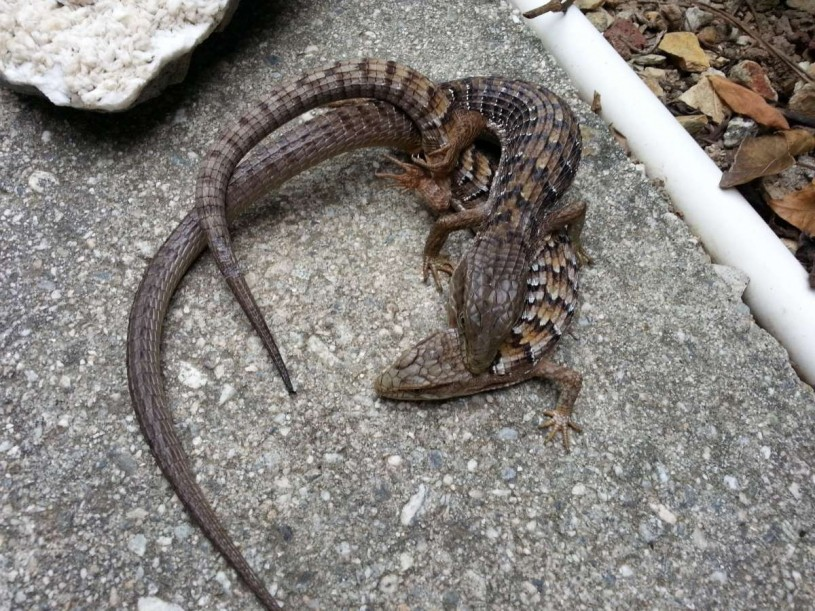If you live south of the Yangtze River, especially in Guangdong and Guangxi, you are likely to have seen these small lizards with particularly short calves and feet, and they are biting each other, as if trying to eat each other...

These little guys are stone dragons.
It is a separate family of lizards in the suborder Lizards, and also has the same name. The plesiosaur family is the most diverse of lizards, with about 1500 species. They share many of the common features of snakes and lizards, with shorter legs than typical lizards, and can be found everywhere except in the North and South Poles and subpolar regions.
Evolutionary transition types
When did these little short feet appear?
The earliest recorded fossil specimens are from the early Cretaceous period, 140 million years ago. Although they are very similar to lizards and geckos, a closer look will reveal that most species of stone dragons have no obvious neck like snakes, and even some species have no limbs at all.
There are about 30 species of legless stone dragons in southern Africa, which are often thought of as snakes, but are actually more like large scaled earthworms, spending most of their lives underground, using enlarged and hardened beak (nose) scales to arch the dirt, ironically, evolving earthworms whose main food is also earthworms (and other underground bugs).
More like earthworms, after heavy rains, these legless stone dragons will climb out of the ground in search of a mate. Slow and clumsy, they are the delicacy of snakes and other animals.
Unlike snakes, legless stone dragons can blink and close their eyes, and their tongues are not forked like snakes, but more like the standard tongue of mammals.
In addition to the legless, some species with particularly short legs also move in a similar way to snakes, rather than running like those lizard relatives with well-developed limbs.
Back to the scene at the beginning where the same kind of people tear each other apart
Are they fighting, trying to eat each other, or are they doing something completely different?
While the scene looks like a fight between two stone dragons, a little more time (about 30-60 minutes) will reveal that this is actually a form of their courtship, rough love – the male bites the back of the female's head during mating until the female is ready.
Some studies have speculated that this mating style is a manifestation of male strength to prove that they are worthy of a partner. Although it may seem rough and unfriendly, it is almost harmless to females.
The reason is actually simple: although the stone dragon is a carnivore, this meat is limited to bugs. Typical prey includes flies, crickets, grasshoppers, earthworms, millipedes, centipedes, snails, slugs, and more. Found that no, all soft guys. They have no teeth in their mouths, only some exoskeletons used to squeeze bugs.
This kind of violent love will at most cause the stone dragon to lose its tail, and sometimes it is the male side that falls. A lost tail can grow back in three to four months, but it will be shorter. Well, some stubby-tailed stone dragon species don't have the ability to regenerate with broken tails.
Egg birth or fetal birth?
If you see two or more stone dragons in a small area, you will definitely find a nest nearby.
Stone dragons "guard" their nest areas. In coastal areas, the lair of the stone dragon often appears in houses and apartments, and you can find 4-8 small white eggs in them.
While most species of leptosaur are oviparous, about 45% of pteropod species are oviparous — first eggs, then hatched in the mother's body, and then come out as adults.
Even, in some genera, it is directly fetal birth. For example, the blue-tongued lizard (Tiliqua) and the capuchin lizard (Corucia), the larva develops in the reproductive tract, the female has a placenta similar to mammals, and the larvae can directly obtain nutrition. In very extreme cases – they have a pure reptile placenta that is almost identical in structure and function to the true placenta.
Evolution is magical, and this can be understood as the same end result of natural selection. The development of the placenta of the stone dragon is systemically similar to that of mammals, but it is certainly not homologous.
Write at the end of the trial method
I still remember when I was a child, I once caught a stone dragon and was bitten.
Although the fact of being bitten was frightening, it was soon discovered that it did not hurt at all. This is surprising considering the still delicate skin of the naughty child at that time.
Under the trend of curiosity, he put his finger over again, and Shi Longzi resolutely bit down and did not let go. The little guy bit his finger as hard as he could, so he let it hang on his finger for nearly 40 minutes until he saw blood.
I thought it must have been the little guy who ended up cutting the skin of his fingers, but it wasn't. The poor little fellow had worked so hard that his little jaw or somewhere else in his mouth had broken, wounding itself, and the blood was flowing from his mouth.
With a sense of guilt, the first moment of letting go of the mouth, I quickly released it.
The author thanks you for your attention (¬_¬)